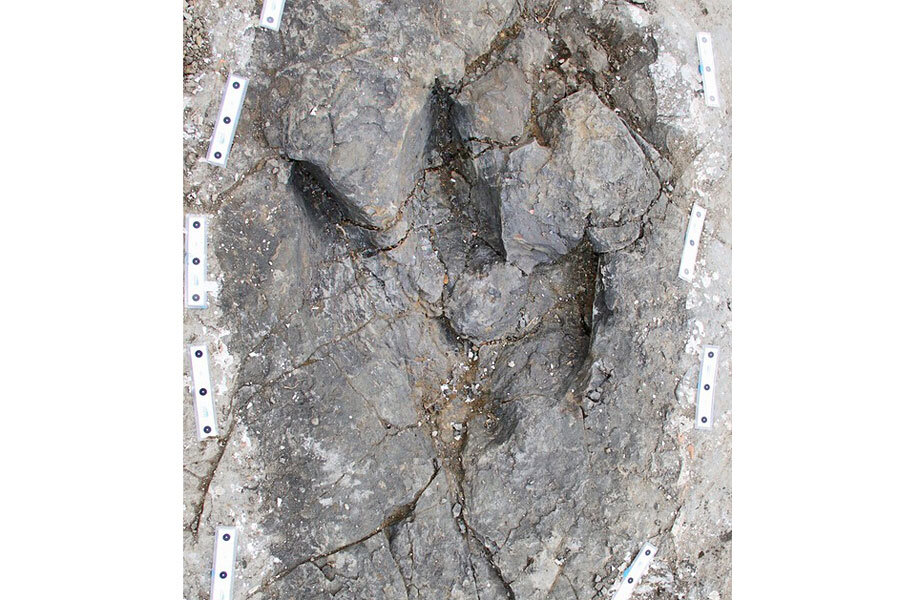Were tyrannosaurs pack hunters? Parallel tracks suggest they did.
Loading...
Some 70 million years ago, three tyrannosaurs stalked together across a mud flat in Canada, possibly searching for prey.
The new insight comes from several parallel tyrannosaur tracks unearthed in Canada. The dinosaur tracks provide stronger evidence for a controversial theory: That the fearsome mega-predators hunted in packs.
The ferocious beasts may have "stuck together as a pack to increase their chances of bringing down prey and individually surviving," said study co-author Richard McCrea, a curator at the Peace Region Palaeontology Center in Canada. [See Images of the Giant Tyrannosaur Tracks]
Tyrannosaur hunting
Paleontologists have long debated whether Tyrannosaurus rex and its cousins, such as Albertosaurus, hunted alone or in groups.
While most researchers believe the predators were lone wolves, so to speak, multiple Albertosaurusspecimens found in a single bone bed in Canada's Dry Island Buffalo Jump Provincial Park have led some to propose that tyrannosaurs were pack animals.
But finding groups of bones together isn't definitive evidence for pack hunting, because bones can move after death. Other circumstances can cause fossil skeletons to accumulate in one location. For instance, many carnivores wandered individually into classic predator traps, such as the La Brea tar pits in Los Angeles, but probably didn't hunt together in life, McCrea said.
Track marks unearthed
In 2011, a local hunting outfitter and guide, Aaron Fredlund, unearthed two tyrannosaur track marks in the foothills of the Canadian Rockies in British Columbia and then told McCrea's team about the discovery.
The team eventually discovered a patch 197 feet (60 meters) long by 13 feet (4 m) wide filled with footprints from multiple dinosaurs, including tyrannosaurs, other small theropods, and duck-billed dinosaurs called hadrosaurs. These dinosaurs were apparently walking in the silty sediments from an overflowing river and formed the track marks about 70 million years ago. A thick layer of volcanic ash then preserved the marks, McCrea said.
In total, the team found seven tracks that were made by three tyrannosaurs. Though the researchers couldn't identify the specific species, it's likely given the period and location where they were found thatAlbertosaurus, Gorgosaurus or Daspletosaurus left the tracks, McCrea said.
Though the other dinosaur tracks there are all pointing in random directions, the tyrannosaur footprints are parallel with each other. The tyrannosaurs also left prints of about the same depth in the wet sediments, suggesting they crossed through the area at the same time. (As the mud dries, the depth of footprints becomes shallower.)
The new find may be one of the world's oldest examples of a missed connection. "The hadrosaur footprints are much more shallow, indicating that they came later," possibly just a few hours or days after the tyrannosaurs, McCrea told Live Science.
Pack animals
The new tracks suggest that the tyrannosaurs may have hunted in packs to take down large prey, just as wolves do today.
"An individual wolf would not be able to take out a moose, but a pack of them would," McCrea said.
Similarly, pack hunting could explain how tyrannosaurs could kill hadrosaurs, which are almost as large as the predators, without sustaining horrific injuries, he said.
That doesn't mean tyrannosaurs would have been friendly to one another. In fact, other fossils reveal thatthe dinosaurs liked to head-bite each other. But the tyrannosaurs may have stuck together to hunt because it increased their odds of survival, McCrea said.
The new discovery also highlights the rough life of these hunters. One of the beasts was missing bones in its left foot, which is in keeping with many of the injuries found on other tyrannosaur specimens, McCrea said.
The trackmarks were described today (July 22) in the journal PLOS ONE.
Follow Tia Ghose on Twitter and Google+. Follow Live Science @livescience, Facebook & Google+. Original article on Live Science.
- Image Gallery: 25 Amazing Ancient Beasts
- Image Gallery: Dinosaur Daycare
- Paleo-Art: Dinosaurs Come to Life in Stunning Illustrations
Copyright 2014 LiveScience, a TechMediaNetwork company. All rights reserved. This material may not be published, broadcast, rewritten or redistributed.





